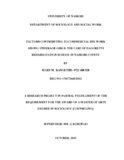| dc.description.abstract | The main objective of this study was to establish factors contributing to Commercial
Sexual Exploitation of girls. The study had four specific objectives, namely establishing
factors contributing to commercial sexual exploitation of underage girls, the agents
involved in the planning, organizing and execution of commercial sexual exploitation of
underage girls, understanding how commercial sexual exploitation of underage girls is
planned, organized, and executed by agents. The other objective of this study was to
identify policy gaps in the already existing policy frameworks developed to combat
Commercial Sexual Exploitation of Children. The research questions were derived from
the above objectives.
The research adopted a qualitative study design. The targeted population was government
officers, especially those involved in child welfare programmes and girls undergoing
rehabilitation at Dagoretti Rehabilitation School. Respondents were randomly and
purposively sampled where asample of twenty nine(29) keyinformants(stakeholders )and
eight (8) girls from a population of one hundred and fifty two (152)respondentsand fifty
(50) girls respectively selected. Interview guides were used to collect data from
respondents and key informant persons. The researcher also conducted one focus group
discussion of adult women who were former commercial sex workers. The data collected
was coded and grouped into themes based on the objectives of the study. Interpretation
was then made by thematic analysis.
The findings reveal that many factors ranging from socio-economic, situational and
individual contribute to Commercial Sexual Exploitation of girls. The socio-economic
and environmental factors are processes that exist in the larger environment over which
young girls can exercise only minimal control but which; nonetheless, exert a powerful
influence on their lives by pushing them into sex work. They include poverty, polluted
social environment, ignorance, corruption and laxity in enforcing existing laws.
Situational factors as the study established are socio-behavioural and family relationship
events that in one way or the other contribute to Commercial Sexual Exploitation of
underage girls: These are external factors that impact underage girls directly and over
which they can exert some measure of control, but which nonetheless push them into sex
work. They include recruitment by family members, peer pressure, stigma and
discrimination, family breakdown/dysfunction. On the other hand, individual/internal
factors are cognitive and psychogenic forces that may push underage girls into sex work.
These include; Poor self esteem; revenge-intentional spread of HIV, and personal drug
dependency
The study also found out that three categories of agents are involved in Commercial
Sexual Exploitation of girls namely; perpetrators, vendors and facilitators. Their activities
and operations are highly secretive and operate using sophisticated networks, with some
even using pseudo names. The study also established a number of policy gaps in the
already developed policy framework which range from preventive,
implementation/enforcement and legislation.
The study therefore concluded that protection programmes needed to be reviewed as a
matter of urgency, besides updating the operational capacity of law enforcers and other
child welfare agencies tasked with the responsibility of child rights and protection.
Efforts at protecting girls from sexual exploitation must emphasize prevention as the first
priority. The study recommends the protection of girls and proper rehabilitation of
victims of child sexual exploitation, and also enforcefully, existing national Laws on
child sexual exploitation | en_US |

